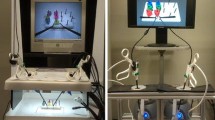Abstract
Background
A robotic virtual-reality (VR) simulator has been developed to improve robot-assisted training for laparoscopic surgery and to enhance surgical performance in laparoscopic skills. The simulated VR training environment provides an effective approach to evaluate and improve surgical performance. This study presents our findings of the VR training environment for robotic laparoscopy.
Methods
Eight volunteers performed two inanimate tasks in both the VR and the actual training environment. The tasks were bimanual carrying (BC) and needle passing (NP). For the BC task, the volunteers simultaneously transferred two plastic pieces in opposite directions five times consecutively. The same volunteers passed a surgical needle through six pairs of holes in the NP task. Both tasks require significant bimanual coordination that mimics actual laparoscopic skills. Data analysis included time to task completion, speed and distance traveled of the instrument tip, as well as range of motion of the subject’s wrist and elbow of the right arm. Electromyography of the right wrist flexor and extensor were also analyzed. Paired t-tests and Pearson’s r were used to explore the differences and correlations between the two environments.
Results
There were no significant differences between the actual and the simulated VR environment with respect to the BC task, while there were significant differences in almost all dependent parameters for the NP task. Moderate to high correlations for most dependent parameters were revealed for both tasks.
Conclusions
Our data shows that the VR environment adequately simulated the BC task. The significant differences found for the NP task may be attributed to an oversimplification in the VR environment. However, they do point to the need for improvements in the complexity of our VR simulation. Further research work is needed to develop effective and reliable VR environments for robotic laparoscopic training.








Similar content being viewed by others
References
Satava RM, Bowersox JC, Mack M, Krummel TM (2001) Robotic surgery: state of the art and future trends. Contemp Surg 57:489–499
Robinson TN, Stiegmann GV (2004) Minimally invasive surgery. Endoscopy 36:48–51
Moorthy K, Munz Y, Dosis A, Hernandez J, Martin S, Bello F, Rockall T, Darzi A (2004) Dexterity enhancement with robotic surgery. Surg Endosc 18:790–795
Chang L, Satava RM, Pellegrini CA, Sinanan MN (2003) Robotic surgery: identifying the learning curve through objective measurement of skill. Surg Endosc 17:1744–1748
De Ugarte DA, Etzioni DA, Gracia C, Atkinson JB (2003) Roboticsurgery an resident training. Surg Endosc 17:960–963
Hernandez JD, Bann SD, Munz Y, Moorthy K, Datta V, Martin S, Dosis A, Bello F, Darzi A, Rockall T (2004) Qualitative and quantitative analysis of the learning curve of a simulated surgical task on the da Vinci system. Surg Endosc 18:372–378
Gutt CN, Oniu T, Mehrabi A, Kashfi A, Schemmer P, Buchler MW (2004) Robot-assisted abdominal surgery. Br J Surg 91:1390 –1397
Hanly EJ, Marohn MR, Bachman SL, Talamini MA, Hacker SO, Howard RS, Schenkman NS (2004) Multiservice laparoscopic surgical training using the da Vinci surgical system. Am J Surg 187:309–315
Donias HW, Karamanoukian RL, Glick PL, Bergsland J, Karamanoukian HL (2002) Survey of resident training in robotic surgery. Am Surg 68:177–181
Guru KA, Kuvshinoff BW, Pavlov-Shapiro S, Bienko MB, Aftab MN, Brady WE, Mohler JL (2007) Impact of robotics and laparoscopy on surgical skills: a comparative study. J Am Coll Surg 204:96–101
Moorthy K, Munz Y, Dosis A, Hernandez J, Martin S, Bello F, Rockall T, Darzi A (2004) Dexterity enhancement with robotic surgery. Surg Endosc 18:790–795
Sarle R, Tewari A, Shrivastava A, Peabody J, Menon M (2004) Surgical robotics and laparoscopic training drills. J Endourol 18:63–67
Mehrabi A, Yetimoglu CL, Nickkholgh A, Kashfi A, Kienle P, Konstantinides L, Ahmadi MR, Fonouni H, Schemmer P, Friess H, Gebhard MM, Buchler MW, Schmidt J, Gutt CN (2006) Development and evaluation of a training module for the clinical introduction of the da Vinci robotic system in visceral and vascular surgery. Surg Endosc 20:1376–1382
Hanly EJ, Zand J, Bachman SL, Marohn MR, Talamini MA (2005) Value of SAGES Learning Center in introducing new technology. Surg Endosc 19:477–483
Dohi T (2004) The overview of robot surgery. Nippon Rinsho 62:824–830
Weiss H, Ortmaier T, Maass H, Hirzinger G, Kuehnapfel U (2003) A virtual-reality-based haptic surgical training system. Comput Aided Surg 8:269–272
Kypson A, Nifong LW, Chitwood Jr WR (2004) Robot-assisted surgery: training and re-training surgeons. Int J Med Robot 1:70–76
Narazaki K, Oleynikov D, Stergiou N (2006) Robotic surgery training and performance: identifying objective variables for quantifying the extent of proficiency. Surg Endosc 20:96–103
Judkins T, Oleynikov D, Narazaki K, Stergiou N (2006) Robotic surgery and training: electromyographic correlates of robotic laparoscopic training. Surg Endosc 20:824–829
Basmajian JV, De Luca CJ (1985) Muscles alive, their functions revealed by electromyography. Williams & Wilkins, Baltimore, MD
Bonato P, Roy SH, Knaflitz M, Luca CJD (2001) Time-frequency parameters of the surface myoelectric signal for assessing muscle fatigue during cyclic dynamic contractions. IEEE Trans Biomed Eng 48:745–753
Rosenthal R, Gantert WA, Scheidegger D, Oertli D (2006) Can skills assessment on a virtual reality trainer predict a surgical trainee’s talent in laparoscopic surgery? Surg Endosc 20:1286–1290
Grantcharov TP, Bardram L, Funch-Jensen P, Rosenberg J (2003) Learning curves and impact of previous operative experience on performance on a virtual reality simulator to test laparoscopic surgical skills. Am J Surg 185:146–149
Lehmann KS, Ritz JP, Maass H, Cakmak HK, Kuehnapfel UG, Germer CT, Bretthauer G, Buhr HJ (2005) A prospective randomized study to test the transfer of basic psychomotor skills from virtual reality to physical reality in a comparable training setting. Ann Surg 241:442–449
Acknowledgements
This work was supported by NIH (K25HD047194), NIDRR (H133G040118), and the Nebraska Research Initiative.
Author information
Authors and Affiliations
Corresponding author
Rights and permissions
About this article
Cite this article
Katsavelis, D., Siu, KC., Brown-Clerk, B. et al. Validated robotic laparoscopic surgical training in a virtual-reality environment. Surg Endosc 23, 66–73 (2009). https://doi.org/10.1007/s00464-008-9894-z
Received:
Revised:
Accepted:
Published:
Issue Date:
DOI: https://doi.org/10.1007/s00464-008-9894-z




